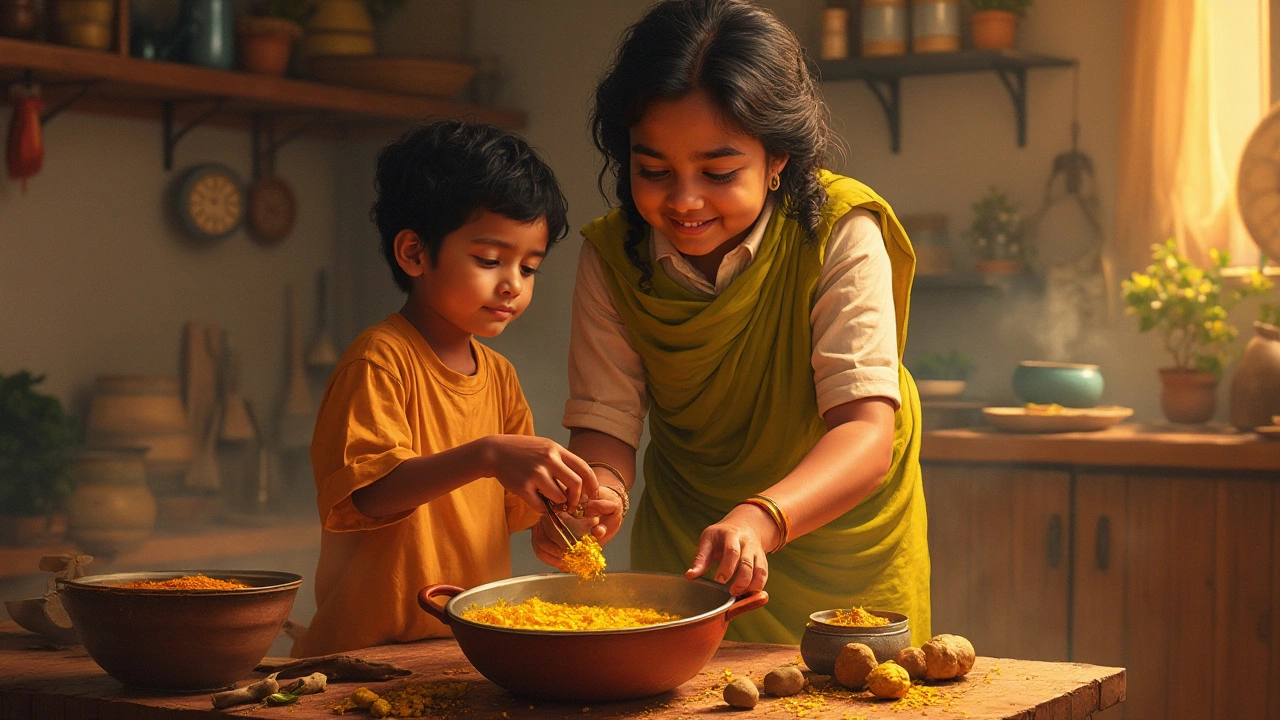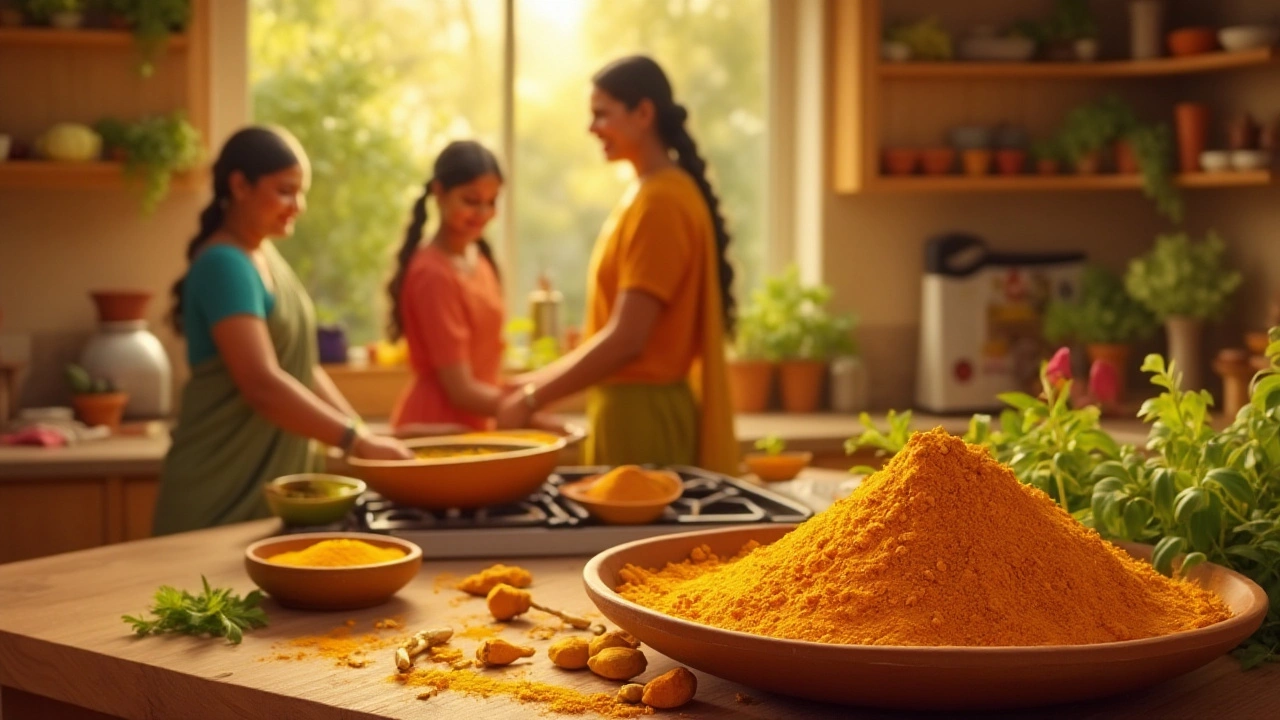Inflammation might sound like a minor discomfort, but it's the notorious foundation of numerous ailments ranging from arthritis to allergies.
Thankfully, nature's pantry offers a treasure trove of solutions, and right at the forefront is turmeric. Revered for centuries in traditional medicine, this vibrant yellow spice is a staple in many households, especially in savory dishes like dal. Imagine a dish that not only tantalizes your taste buds but also works wonders for your health.
In this journey into the world of inflammation-fighting foods, we delve into the wonders of turmeric and guide you in crafting an irresistible, health-boosting dal. Equipped with essential tips and insights, you'll be on your way to mastering both the art and science of creating a delightful dish that could just be the remedy you need.
- Understanding Inflammation
- Turmeric: Nature's Healer
- Essential Spices in Dal
- Simple Turmeric Dal Recipe
- Tips for Enhanced Flavor
Understanding Inflammation
In our bodies, inflammation is the steadfast soldier of the immune system, rushing to protect us from invading pathogens and heal injuries. Picture it as a double-edged sword. On one side, it's crucial for our survival, fostering recovery from infections and injuries. But on the flip side, when this immune response becomes chronic, it turns against us, potentially causing more harm than good. That's the tricky nature of inflammation - it's both friend and foe.
Chronic inflammation is the type we often hear about in wellness circles, linked to diseases that don't show immediate symptoms. It occurs when the inflammatory process persists, often silently, leading to damage over time. Experts connect it with conditions like diabetes, heart disease, and even Alzheimer’s. Imagine your immune system continuously fighting an unseen enemy; that's the exhausting situation chronic inflammation presents to the body.
A fascinating tale about inflammation is its connection with lifestyle. Researchers have established that factors like diet, stress, lack of exercise, and even environmental pollutants can fuel this fire. Embracing an anti-inflammatory diet is frequently touted as a proactive approach to lessen this burden on one’s health. Here, the heroics of certain foods like turmeric become clear. Anti-inflammatory foods wield the power to naturally soothe and prevent chronic inflammation, leading to a symphony of balance and wellness in the body.
Cleveland Clinic notes, "A consistent, anti-inflammatory way of eating is one of the best things you can do to lower your chances of developing a serious condition over your lifetime."
It’s not just human health that informs us about inflammation. Our ancestors grappled with it too, evidenced by ancient texts that describe remedies akin to today’s natural treatments. The pursuit of harnessing dietary allies like turmeric to counteract inflammation isn't new; it's a rediscovery of age-old wisdom with a modern twist. Understanding inflammation, therefore, not only entails grappling with scientific data but also respecting the insights of those before us.
In grappling with inflammation, knowledge is empowerment. Understanding the roles and triggers of inflammation equips us with the wisdom to anticipate and address the challenges it presents. Whether through the delicate balance of lifestyle choices or the mindful incorporation of foods like turmeric into our diets, we possess the tools to potentially transform this double-edged sword into an ally.
Turmeric: Nature's Healer
Turmeric, a golden-hued spice, holds a revered place in the world of natural remedies, and it’s no wonder why. Tracing its origins to South Asia, this powerful root has been an essential part of Ayurvedic medicine for over 4,000 years. The secret ingredient that catapults turmeric to its star status is curcumin, a compound with remarkable anti-inflammatory properties. Curcumin acts as a natural painkiller and is known for its ability to thwart inflammation before it escalates into chronic conditions. It's not just anecdotal evidence that backs up these claims; science is on our side. Multiple studies have shown curcumin to be as effective as some anti-inflammatory drugs, sans the adverse side effects. Imagine cooking with a spice that could outperform over-the-counter medicines, making it an invaluable asset in your kitchen arsenal.
Curcumin's effectiveness in reducing inflammation is bolstered when it's consumed with the right companions. For instance, black pepper contains piperine, a compound that enhances curcumin absorption by 2,000%. That's a staggering increase that signifies the importance of using black pepper in tandem when preparing dishes like dal. Consuming turmeric with a healthy fat source, like coconut oil or ghee, also improves its bioavailability, making it easier for the body to reap the benefits. These simple adjustments in your culinary practices can amplify the health benefits you get from turmeric many times over. Hence, incorporating turmeric into your daily diet, especially through a delectable dal, is not just a flavorful decision, but a strategic one for your health.
In the quest to understand turmeric's prowess better, we can draw insights from experts in the field.
Dr. Bharat Aggarwal, a molecular biologist with years of research on curcumin, once remarked, "Curcumin is perhaps, the most quoted compound in history when it comes to fighting inflammation, and now, it is the topic of extensive research worldwide."His work and that of many others highlight not just the spice’s potential to heal existing maladies but also its preventive capabilities. Eating turmeric regularly is akin to building a protective barrier against future health issues. The integration of this simple yet miraculous spice into your daily meals could potentially transform your health landscape.
Despite its robust potential, turmeric usage isn't about going solo; it's about combination and proportion. Let's look into how turmeric works synergistically with other ingredients in a dal recipe to maximize its health benefits. By understanding the interaction between turmeric and complementary spices, one can aim to craft a meal that's not only tasty but also a therapeutic powerhouse. Creating meals that heal is not just an aspiration but a reality that can be achieved with the knowledge and right application of turmeric's anti-inflammatory properties.

Essential Spices in Dal
Creating a delectable dal isn't just about boiling lentils; it's a medley of flavors and aromas brought to life by a symphony of essential spices. These ingredients, each with its own unique attributes, work harmoniously to craft a dish that is as comforting as it is invigorating. Traditional Indian kitchens have long understood the importance of spices, and their use in dal recipes is both art and culture. Every spice contributes not just flavor but a bounty of health benefits. For instance, cumin is known for its ability to aid digestion, a vital element considering the fiber-rich nature of lentils. Adding cumin seeds during the tempering process releases an earthy aroma, setting the stage for the delightful dish ahead.
Mustard seeds are another popular choice; they crackle with life when they meet hot oil, infusing the dal with an intensity that's hard to miss. Beyond flavor enhancement, mustard seeds have properties that can help regulate metabolism and reduce inflammation. Then there's the aromatic ginger, a staple in many dal preparations. It's not only the warming spice that offers a tangy zing but also a natural anti-inflammatory, perfect for those looking to alleviate joint pain or muscle stiffness. Anti-inflammatory foods, much like ginger and turmeric, are especially prized for their medicinal benefits. As Dr. Sanjay Gupta once said,
"Spices are not just flavorings; they're a substantial part of a nutritious diet that can have profound effects on your health."
Garlic, another indispensable ingredient, complements ginger beautifully, bringing its own potent, health-boosting qualities to the table. Known as a natural antibiotic, garlic can help ward off illness and improve heart health. Turmeric, with its characteristic golden hue, has been at the forefront of inflammation relief, lending not only its color but its remarkable health-boosting properties. This spice, often paired with a dash of black pepper to enhance absorption, is known to battle inflammation at the root level, making it an indispensable part of any dal.
If you love the rich, spicy notes, then adding a pinch of red chili powder might just be what you need. Known for spiking metabolism and enhancing circulation, this fiery spice adds heat that perfectly balances the mellowness of the lentils. However, perhaps the jewel in the crown of any dal preparation is asafoetida or hing. A little goes a long way with this powerful spice. Its pungent aroma, though not always immediately appealing, transforms as it cooks, lending complexity and depth to the dal's flavor profile.
The rich tapestry of spices used in dal is not randomly assembled but rather carefully curated over centuries. Recognizing the benefits each spice offers, from turmeric's healing to cumin's comforting touch, provides insight into why dal remains a staple in so many diets. Intentionally combining these anti-inflammatory foods with the natural protein sources found in lentils, you're crafting a dish that is a true testament to both culinary tradition and modern nutritional wisdom. So, when preparing your next bowl of dal, remember these elements are not just enhancing your meal's flavor, they're enriching your health too.
Simple Turmeric Dal Recipe
The simplicity of a dal recipe lies not just in its ingredients, but in the heart and soul that go into crafting a dish that is both nurturing to the body and the senses. Turmeric, with its unmistakable golden hue and earthy aroma, is the star of this culinary masterpiece, renowned for its ability to combat inflammation. But how does one create a dal that harmonizes flavor and health benefits? It begins with choosing the right lentils. While the robust toor dal, or split pigeon peas, are often favored, the petite masoor dal offers an equally delightful and quicker cooking alternative, loaded with proteins and fiber essential to any diet. Mixing these with an array of spices turns an ordinary lentil dish into a powerhouse of nourishment and taste.
First, rinse about a cup of your chosen lentils thoroughly until the water runs clear. This step removes any impurities and yields a smoother texture. In a pot, combine the cleaned lentils with around three cups of water and a half teaspoon of turmeric. Optionally, add a pinch of salt and a bay leaf for a subtle depth of flavor. Bring these to a boil, then simmer covered until the lentils are tender, typically taking 20 to 25 minutes. While the lentils are cooking, prepare the tadka, which is the sizzling infusion of spices that elevates the dal from simple to sensational.
For the tadka, heat a tablespoon of ghee or vegetable oil in a small pan. Add jeera, or cumin seeds, and let them crackle, releasing their nutty aroma. Follow with minced garlic, ginger, and a finely chopped onion. As the ingredients turn golden, stir in chopped tomatoes, green chilies, and another half teaspoon of turmeric. As the mixture stews, it becomes a fragrant melange that is then stirred into the waiting lentils, bringing the aromatic spices alive in every morsel. Some recipes call for the inclusion of mustard seeds, curry leaves, and asafoetida, creating a signature South Indian twist, though it remains a versatile dish adaptable to various regional preferences.
Should you be inspired by culinary mastery, you might explore the statements of chefs who praise this dish's adaptability.
"Turmeric isn't just a spice for color; it's a testament to ancient wisdom meeting modern palates," says Chef Anjum Anand, an advocate of healthy Indian cooking.If you're keen to experiment, consider adding vegetables like spinach or squash to the dal for added nutrients, crafting a balanced meal all in one pot. The fun lies in the experimentation, finding your balance of spices, and enjoying the creativity of adapting them to personal taste.
| Ingredient | Quantity | Health Benefit |
|---|---|---|
| Turmeric | 1 tsp | Anti-inflammatory |
| Lentils | 1 cup | High in protein |
| Garlic | 4 cloves | Immune support |
| Cumin | 1 tsp | Digestion aid |
Finally, garnish your culinary creation with fresh coriander or a splash of lemon juice to lift the flavors. Serve this nourishing turmeric dal with steaming basmati rice or whole wheat rotis, and you've crafted a comforting, anti-inflammatory delight. Sharing this recipe with loved ones can spread joy just as effectively as it promotes health. Remember, the joy in cooking lies in the journey, not just the destination. Celebrate each step, and let each spice play its part on this flavorful stage.

Tips for Enhanced Flavor
Adding depth and richness to your turmeric dal involves more than just dumping ingredients into a pot. The magic lies in how those ingredients are prepared and combined. Start by roasting your spices. Heating spices like cumin and mustard seeds in a dry pan unlocks oils and brings a nuttiness that transforms your dal. When using fresh ingredients, chopping garlic, onions, and ginger finely ensures they dissolve seamlessly into the dish. This contributes to a harmonious blend and a mouthfeel that invites each bite, enhancing the vibrant taste of your anti-inflammatory dal. Blending these aromatics with a touch of ghee can amplify the flavor, providing a creamy texture that carries the spices effortlessly.
"The secret to outstanding dal is the interplay of spice and technique," according to Chef Madhur Jaffrey, a renowned authority in Indian cooking. "Cooking it tenderly and patiently with just the right balance of ingredients makes all the difference."
Mind the salt. While an essential component, it can overpower other flavors if used excessively. Season gradually, tasting as you go to ensure a balance that highlights the compelling benefits of turmeric. Moreover, consider adding a squeeze of fresh lemon or lime right before serving. The acidity cuts through any richness and offers a refreshing contrast that brightens the dal recipe significantly. Another flavorful tactic involves a final finishing touch of fresh herbs like coriander or mint. These herbs not only decorate the dish appealingly but bring an added aromatic layer that's both visually and gustatorily pleasing.
If you're aiming for a slightly richer profile, incorporating coconut milk can be transformative. It offers a delicate sweetness and creaminess that softens the spice while making the dish feel luxurious. For those who appreciate a nutty twist, a sprinkle of toasted almonds or cashews can add a surprising and pleasant crunchy texture. And when entertaining the idea of a bit of zest, think about the inclusion of freshly ground pepper or a pinch of chili flakes to introduce a nuanced heat that excites the palate without overwhelming it.
Finally, be mindful of the cooking time. Overcooking your dal can lead to a mushy texture, whereas undercooking it might leave it tasting raw. Generally, allowing the lentils to simmer gently for approximately 25-30 minutes leads to a perfect consistency, where flavors deepen and mellowness and balance are achieved. By following these seasoned tips, your turmeric dal won't just be nourishing—it will be an exquisite core piece of any meal, one that streaks deep comfort and abundant flavor in every spoonful.
